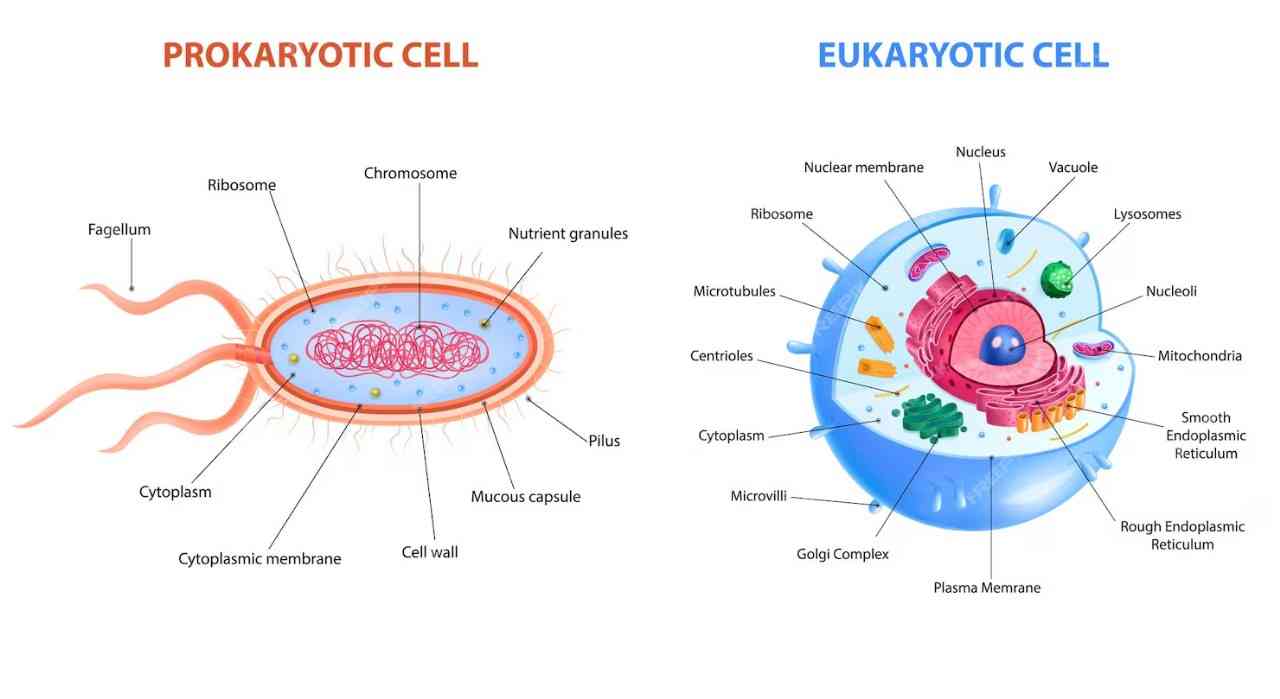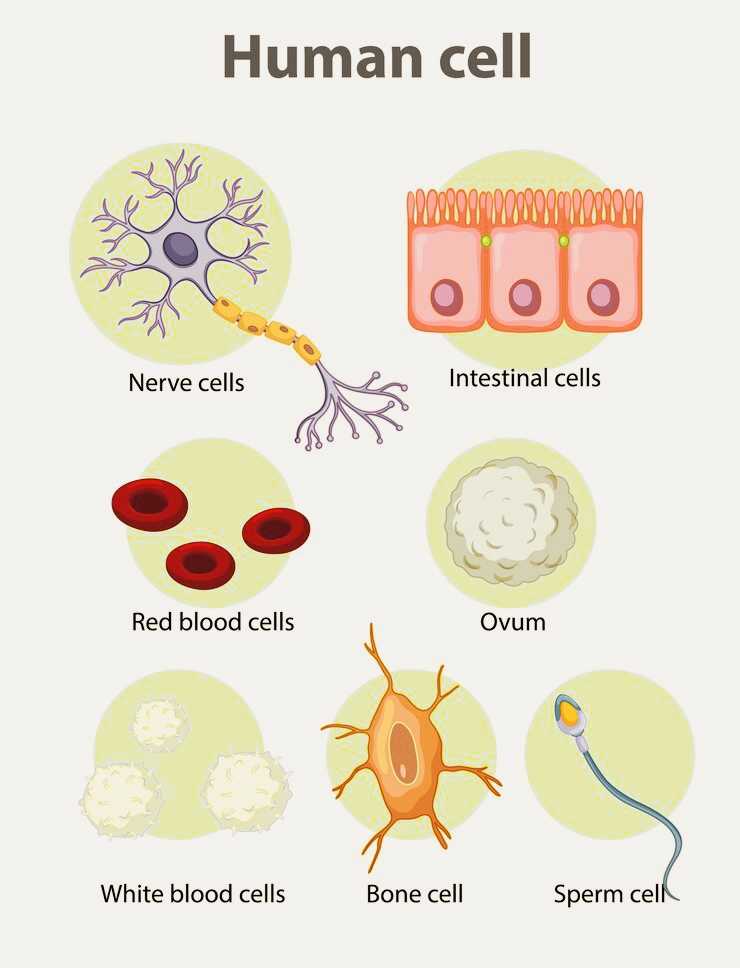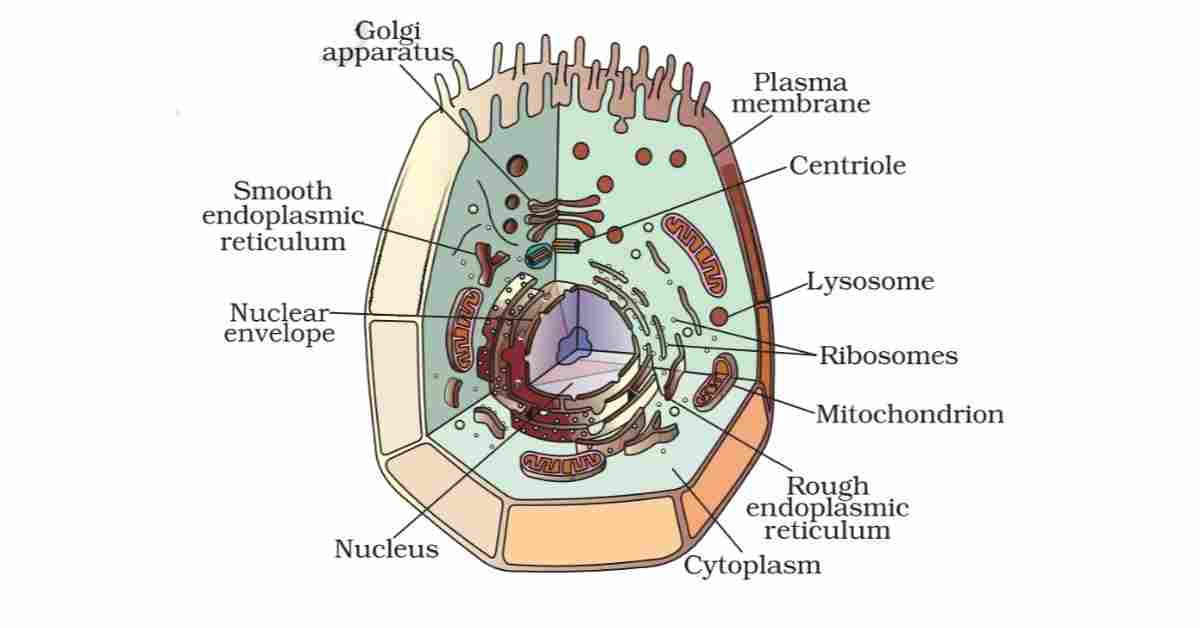Introduction
In 1665, while examining a thin slice of cork through a self-designed microscope, Robert Hooke observed a honeycomb-like structure with many small compartments. Cork, derived from tree bark, revealed these compartments, which Hooke named “cells” from the Latin word for “a little room.” This significant discovery marked the first observation of living organisms consisting of distinct units, a concept fundamental to modern biology. Let’s find out about cells.
Cell
A Cell is the structural and functional unit of living organisms. The study of structure and composition of all cells is called as ‘Cytology’. In 1665, Robert Hooke, under a simple microscope, observed beehive-like structures in a piece of decayed cork, which were dead cells. while the first living cell was discovered by Antonie Van Leeuwenhoek in 1674.
Protoplasm
Protoplasm is the living content of the cell.
Note: Jan Evangelista Purkyne coined the term ‘protoplasm’ for the fluid substance of the cell in 1839.
Classification of organisms based on cell composition
Based on the number of cells present in different organisms, they are of the following two types:
1. Unicellular organisms
Unicellular organisms are living beings that consist of only a single cell.
e.g. Paramecium, Bacteria etc.
- These organisms are capable of performing all the necessary functions for life such as metabolism, growth, and reproduction.
2. Multicellular organisms
Multicellular organisms are living beings that consist of more than one cell.
e.g. Plants and Animals
These cells are specialized and organized into tissues, organs, and systems that work together to support the life of the organism.
Cell Shape: Cells have many different shapes
Cell Size: There are many types of cell sizes
Note 1. The largest cell is the ostrich egg.
Note 2. The longest cell is the nerve cell.
Note 3. The smaller cell so far known is mycoplasma.
On the basis of nucleus cells are two types.
Prokaryotic cell: Nucleus is undefined and is called nucleoid. Membrane-bound organelles are absent.
Eukaryotic cell: The Nucleus is well-defined by the nuclear membrane. Cell organelles are membrane-bound.

Difference between Prokaryotic Cells and Eukaryotic Cells
| Prokaryotic Cells | Eukaryotic Cells |
|---|---|
| Many cell organelles are absent. | Cell organelles are present. |
| Very small in size | Fairly large in size |
| No defined nuclear membrane. | Well-defined nuclear membrane. |
| Nucleous is absent | Nucleus is absent |
| An undefined region region with nucleic acids is termed as nucleoid. | Reason bounded by nuclear membrane contains DNA and protein. |
| Cell division by fission or budding | Cell division by mitosis or meiosis |
| e.g. Bacteria cell | e.g. Plants and Animals cell |

Components of Cell
The five basic components of all the cells are:
- Plasma membrane / Cell membrane
- Cell wall
- Nucleus
- Cytoplasm
- Cell organelles
1. Plasma Membrane
The plasma membrane, a thin layer surrounding cells, regulates the passage of substances in and out, maintaining cellular stability and function.
Function of Plasma Membrane
- The plasma membrane is flexible and is made up of lipids and proteins.
- The plasma membrane is selectively permeable.
- The plasma membrane allows or permits the entry and exit of some materials in and out of the cell.
Cell Membrane
- The cell membrane is also called as the plasma membrane.
- It limits the boundary of each cell that separates the cytoplasm from its surroundings.
- It is found in both plants as well as animal cells.
- It is made up of proteins and lipids.
- The plasma membrane is selectively permeable. It allows or permits the entry and exit of some materials in and out of the cell.
- It is flexible and can be folded, broken and ruined.
Transport Through Cell Membrane
The movement of substances from outside the cell to the inside of the cell through the plasma membrane is possible through some processes, which are as follows-
- (i) Passive transport: The movement of material from its higher to lower concentration is called active transport.
Passive transport has two types
- (i) Diffusion: This is the spontaneous movement of substances ( solid, liquid and gases ) from a region of high concentration to a low concentration. It can be inside the cell or inside and outside of the cell. e.g. Substances like carbon dioxide or oxygen can move across the cell membrane by diffusion.
- (ii) Osmosis: Osmosis is the spontaneous movement of solvent or water molecules from a higher concentration region to a lower concentration region through a selectively permeable membrane.
Osmosis could be endosmosis or exosmosis.
- Endosmosis: Endosmosis is the movement of solvent into the cell.
- Exosmosis: Exosmosis is the movement of solvent outside the cell.
Active Transport: The movement of material from its lower to higher concentration is called active transport.
Difference between Passive transport and Active transport
| Passive transport | Active transport |
|---|---|
| 1. Substances move from their lower to higher concentration. | 4. Movement of large molecules occurs by active transport. |
| 2. No energy is required. | 2. It requires energy in the form of ATP molecules. |
| 3. It is a slow movement. | 3. It is a rapid movement. |
| 4. Only small molecules or water molecules are transported passively. | 4. Movement of large molecules occurs by active transport. |
Hypertonic Solution
A hypertonic solution has a higher concentration of solutes compared to the cell’s interior, causing water to exit the cell, and resulting in cell shrinkage due to osmotic pressure differences.
Hypotonic Solution
A hypotonic solution has a lower concentration of solutes compared to the cell’s interior, causing water to enter the cell, which can lead to the cell swelling and possibly bursting.
Isotonic Solution
An isotonic solution has the same concentration of solutes as the cell’s interior, resulting in no net movement of water into or out of the cell, maintaining cell size and shape.
Plasmolysis
Plasmolysis is the process where plant cells lose water in a hypertonic solution, causing the cell membrane to detach from the cell wall.
Or
Shrinkage of protoplasm ( living content of the cell ) away from the cell wall, when placed in a hypertonic solution.
Note: Plasmolysis is observed only in plants.
2. Cell Wall
The cell wall is a rigid, protective layer found outside the cell membrane in plant cells.
- It is the outermost covering of the plant cells.
- It is absent in animal cells.
- The cell wall is rigid, strong and thick.
- It is permeable.
- It is made up of cellulose.
Functions of Cell Wall
- It provides a definite shape to the cell.
- It provides strength to the cell.
- It is permeable and allows the entry of molecules of different sizes.
- It has the characteristics of repair and regeneration.
Difference between Cell Wall and Cell Membrane
| Cell Wall | Cell Membrane |
|---|---|
| It is present in both plant and animal cells. | It is present only in plant cells. |
| It is thin, delicate and flexible. | It is considerably rigid. |
| It is living. | It is non-living. |
| It is selectively permeable. | It is permeable |
Types of cells based on the nucleus
Prokaryotic cell: Nucleus is undefined and is called nucleoid. Membrane-bound organelles are absent.
Eukaryotic cell: The Nucleus is well-defined by the nuclear membrane. Cell organelles are membrane-bound.
3. Nucleus
The nucleus is a membrane-bound organelle found in eukaryotic cells. It is often referred to as the “control center” of the cell because it houses the cell’s genetic material and coordinates various cellular activities.
Or
Nucleous is the most important cell organelle which directs and controls all its cellular activities. It is called the ‘Headquarter of the cell’. It was discovered by Robert Brown in 1831.
Structure
- Nuclear Envelope: A double membrane that surrounds the nucleus, separating it from the cytoplasm. It contains nuclear pores that regulate the exchange of materials (such as RNA and proteins) between the nucleus and the cytoplasm.
- Nuclear Pores: Large protein complexes that span the nuclear envelope, allowing selective transport of molecules in and out of the nucleus.
- Nucleoplasm: The semi-fluid matrix inside the nucleus, which contains chromatin and other nuclear components.
- Chromatin: A complex of DNA and proteins (mainly histones) that condenses to form chromosomes during cell division.
- Nucleolus: A dense, spherical structure within the nucleus, where ribosomal RNA (rRNA) is synthesized and ribosome assembly begins.
Functions
- Genetic Information Storage: The nucleus houses the cell’s DNA, which contains the instructions for all cellular processes and functions.
- Gene Expression Regulation: The nucleus controls which genes are turned on or off, thereby regulating protein synthesis and influencing cell behaviour and function.
- Ribosome Production: The nucleolus within the nucleus is the site of rRNA synthesis and the initial assembly of ribosomes, which are essential for protein synthesis.
- Cell Division: The nucleus plays a key role in cell division (mitosis and meiosis), ensuring the accurate replication and distribution of genetic material to daughter cells.
- Nuclear Transport: The nuclear envelope and pores regulate the movement of molecules between the nucleus and the cytoplasm, maintaining cellular organization and function
Importance
- Central Role: As the repository of genetic information, the nucleus is essential for heredity, growth, and development of eukaryotic organisms.
- Coordination: It ensures that cellular processes such as metabolism, growth, and reproduction are properly coordinated by regulating gene expression and protein synthesis.
Overall, The nucleus controls the metabolic activities of the cell and regulates the cell cycle. It helps in the transmission of hereditary characteristics from parents to offspring.
4. Cytoplasm
The fluid inside the cell enclosed by the plasma membrane is called cytoplasm.
- It is mainly composed of water, salts and proteins.
- The organelles such as mitochondria, the endoplasmic reticulum, and chloroplasts, are contained in the cytoplasm.
- It is a little viscous (almost 80% water)
- It is also termed as ‘Cystosol’
- Many cell organelles are embedded in cytoplasm.
Significance of Cytoplasm
- It can dissolve nutrients.
- It can dissolve waste products.
- It controls the shape of the cell to an extent.
- Organelles embedded in cytoplasm each perform a specific function without which the cell can not function as a whole.
- It helps in cellular respiration with the help of cytoplasmic inclusions.
5. Cell Organelles
Cell organelles are specialized structures within a cell that perform distinct functions necessary for cellular operation and survival.
- All cells have the same organelles, irrespective of their function and the organism they are found in.
- Several cell organelles are suspended in the Cytoplasm
- Each organelle is surrounded by its individual membrane (eukaryotes)

Endoplasmic Reticulum (ER)
It was given this name by Porter. It is a complex network of tubes and sac-like structures spread in the cytoplasm, which is located in the nucleus and extends from the membrane to the cell membrane.
Depending on the presence or absence of ribosomes, endoplasmic reticulum is of the following two types:
(i) Rough or granular endoplasmic reticulum or RER: Due to the presence of ribosomes, it looks rough or granular. It is found in large numbers that cells participate in protein synthesis.
Functions of RER
- Ribosome attached to its surface
- Proteins manufactured in the ribosome, and then transported to other parts through the ER
(ii) Smooth Endoplasmic Reticulum (SER): It is smooth due to the absence of ribosomes. It is found in large numbers mainly in the cells involved in the synthesis of fats and glycogen.
Functions of SER
- No ribosomes are attached here.
- Fat molecules and lipids are manufactured.
Significance of Endoplasmic Reticulum
- Proteins and lipids are manufactured here and these are used in building the plasma membrane, this process is known as Biogenesis.
Functions of Endoplasmic Reticulum
The main functions of the endoplasmic reticulum are as follows:
- It acts as the endoskeleton of the cell.
- It makes the cell elastic and flexible.
- This layer helps in the reconstruction of the nuclear membrane through biogenesis.
- The rough endoplasmic reticulum provides a site for protein synthesis.
- In the liver cells of vertebrate animals, these SERs are helpful in the detoxification of poisons and fluids.
Golgi apparatus
The Golgi apparatus, also known as the Golgi body or Golgi complex, is an essential organelle found in eukaryotic cells. It consists of a series of flattened, stacked pouches called cisternae.
- It is located near the nucleus of animal cells.
- It is freely distributed in plant cells which are also called dictyosomes.
Functions
- Modification: Proteins and lipids received from the ER are modified through the addition of carbohydrate groups (glycosylation) or other modifications necessary for their function.
- Sorting: The Golgi apparatus sorts proteins and lipids based on their destinations. This ensures that each molecule reaches the correct location within or outside the cell.
- Packaging: Modified proteins and lipids are packaged into vesicles for transport. These vesicles can fuse with the cell membrane to release their contents outside the cell (exocytosis) or deliver them to other organelles.
- Lysosome Formation: The Golgi apparatus is involved in the formation of lysosomes, which are organelles that contain enzymes for breaking down cellular waste and macromolecules.
Significance of Golgi apparatus
- Cellular Logistics: The Golgi apparatus acts as a central hub for trafficking cellular products, ensuring they are correctly processed and delivered.
- Secretion: It plays a crucial role in the secretion of substances such as hormones, enzymes, and neurotransmitters.
Overall, the Golgi body modifies, sorts, and packages proteins and lipids for secretion or delivery to other organelles within the cell.
Lysosomes (Sucidal Bag)
Lysosomes are membrane-bound organelles in eukaryotic cells that contain digestive enzymes.
Note: The presence of lysosomes in plant cells is disputed.
Significance of Lysosomes
- It digests waste materials/worn-out organelles.
- It is a waste disposal system of cells.
- It defends against bacterial and viral infection.
- During cell damage, lysosomes burst and the enzymes digest their cell.
Overall, lysosomes are vital for cellular housekeeping, defence, and recycling, ensuring the cell operates smoothly and efficiently.
Mitochondria
Rod-shaped organelles are bounded by two membranes known as the “powerhouses” or the ‘Storage Battery‘ of the cell.
- They generate energy in the form of ATP through cellular respiration and regulate cellular metabolism.
Significance of Mitochondria
- It is the powerhouse of the cell.
- Energy is released in the form of AdenosineTriPhosphate (ATP) molecules.
- It can synthesize their own proteins, as they have their own DNA and ribosome.
Plastids
Plastids are specialized organelles that present only in plant cells and some protists, playing key roles in photosynthesis, storage, and synthesis of various molecules
Plastis are three types:
- Chloroplasts: Green in colour, found in areal parts of plants. These are found only in plant cells. It helps in the process of photosynthesis so it is called the ‘Kitchen of Plants’.
- Leucoplast:
- Chromoplast:
Significance of Plastid
- It helps in photosynthesis.
- It has its DNA and ribosomes; so can make its proteins.
- It is the storage of plant food.
Vacuole
A vacuole is a membrane-bound organelle found in plant and fungal cells, and some protist, animal, and bacterial cells. It plays a crucial role in maintaining cell structure, storage, and waste management.
Significance of Vacuole in Plant Cell
- It contains cell sap and provides rigidity to cells.
- It is the storage of amino acids, sugars and proteins.
Significance of Vacuole in Animal Cell
- It helps in the ingestion of nutrients.
- Maintenance of water balance.
Difference b/w Animal cell and Plant cell
| Plant Cell | Animal Cell |
|---|---|
| 1. It is larger in size. | It is smaller in size. |
| 2. Cell wall is present. | 3. Vacuoles are big and lesser in number. |
| Vacuoles are many and small (not necessarily all animal cells have it) | Plastids are absent. |
| 4. Plastid are present. | Plastid are absent. |
| 5. Contain chloroplast for photosynthesis | No chloroplast as they don’t make their own food |
| 6. Have a cell wall to maintain structure and rigidity | Cells can move around. |
| 7. Limited movement | Cells are fluid and flexible, with many shapes. |
| 8. Cells are square and rigid or geometric-shaped | Cells are square and rigid or geometric-shaped |
Cell division
The process by which new cells are made is called cell division.
Or
Cell division is a fundamental biological process by which a single cell divides to form two new cells.
This process is crucial for growth, development, and repair in living organisms.
There are two main types of cell division:
- Mitosis: This type of cell division results in two daughter cells that are genetically identical to the parent cell. It is essential for growth and the replacement of worn-out cells.
- Meiosis: This type of cell division occurs in the production of gametes (sperm and eggs) in sexually reproducing organisms. It reduces the chromosome number by half, resulting in four genetically unique daughter cells.
We hope that provided CBSE Class 9 Science Notes, "Class 9 Science Notes Chapter 5 The Fundamental Unit Of Lifeound Us Pure?," will be helpful to you. If you have any queries regarding the NCERT Class 9 Science Notes, please drop a comment below, and we will get back to you as soon as possible.

